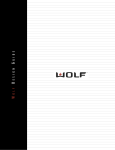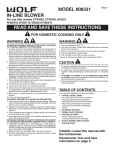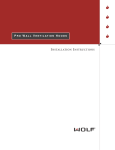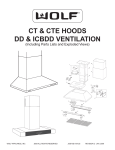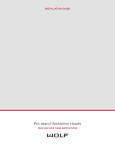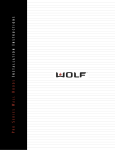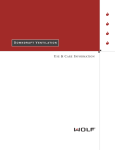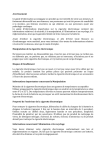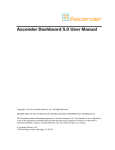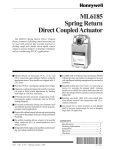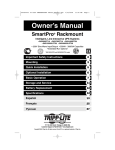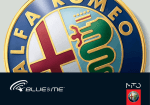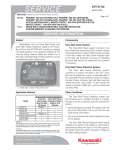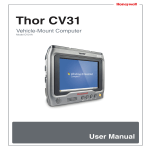Download Wolf 801640 User's Manual
Transcript
MODEL 801640 Page 1 EXTERIOR VENTILATOR KITS ! WARNING CAUTION TO REDUCE THE RISK OF FIRE, ELECTRIC SHOCK, OR INJURY TO PERSONS, OBSERVE THE FOLLOWING: 1. Use this unit only in the manner intended by the manufacturer. If you have questions, contact the manufacturer or your distributor. 2. Before servicing or cleaning unit, switch power off at service panel and lock the service disconnecting means to prevent power from being switched on accidentally. When the service disconnecting means cannot be locked, securely fasten a prominent warning device, such as a tag, to the service panel. 3.Installation work and electrical wiring must be done by a qualified person(s) in accordance with all applicable codes and standards, including fire-rated construction codes and standards. 4. Sufficient air is needed for proper combustion and exhausting of gases through the flue (chimney) of fuel burning equipment to prevent backdrafting. Follow the heating equipment manufacturer’s guidelines and safety standards such as those published by the National Fire Protection Association (NFPA), and the American Society for Heating, Refrigeration and Air Conditioning Engineers (ASHRAE), and the local code authorities. 5.When cutting or drilling into wall or ceiling, do not damage electrical wiring and other hidden utilities. 6. Ducted fans must always be vented to the outdoors. 7. Do not use this unit with an additional speed control device. 8. To reduce the risk of fire, use only steel ductwork. 9. This unit must be grounded. TO REDUCE THE RISK OF A COOKTOP GREASE FIRE: 1. Never leave surface units unattended at high settings. Boilovers cause smoking and greasy spillovers that may ignite. Heat oils slowly on low or medium settings. 2.Always turn hood ON when cooking at high heat or when cooking flaming foods. 3. Clean ventilating fans frequently. Grease should not be allowed to accumulate on fan or filter. 4. Use proper pan size. Always use cookware appropriate for the size of the surface element. TO REDUCE THE RISK OF INJURY TO PERSONS IN THE EVENT OF A COOKTOP GREASE FIRE, OBSERVE THE FOLLOWING:* 1. SMOTHER FLAMES with a close-fitting lid, cookie sheet, or metal tray, then turn off the burner. BE CAREFUL TO PREVENT BURNS. If the flames do not go out immediately, EVACUATE AND CALL THE FIRE DEPARTMENT. 2. NEVER PICK UP A FLAMING PAN - You may be burned. 3.DO NOT USE WATER, including wet dishcloths or towels violent steam explosion will result. 4. Use an extinguisher ONLY if: A.You know you have a Class ABC extinguisher and you already know how to operate it. B. The fire is small and contained in the area where it started. C.The fire department is being called. D. You can fight the fire with your back to an exit. * Based on “Kitchen Fire Safety Tips” published by NFPA. 1. For general ventilating use only. Do not use to exhaust hazardous or explosive materials and vapors. 2. To avoid motor bearing damage and noisy and/or unbalanced impellers, keep drywall spray, construction dust, etc. off power unit. 3. Your ventilator motor has a thermal overload which will automatically shut off the motor if it becomes overheated. The motor will restart when it cools down. If the motor continues to shut off and restart, have the hood serviced. 4. Please read specification label on product for further information and requirements. SPECIFICATIONS MODEL VOLTS 801640 120 AMPS 2.4 CFM 600 DUCT SIZE 10 "DIA. PLAN THE INSTALLATION 1. Locate the ventilator so the length of the duct run and number of elbows and transitions needed are kept to a minimum. 2. Where possible, ventilator should be located between wall studs or roof rafters. 3. Avoid pipes, wires, or other ductwork that may be running through the wall. 4. Be sure that there is enough space for any transitions that may be needed between the ventilator and the connecting ductwork. 5. For best performance, locate transitions nearest to ventilator. MODEL 801640 ROOF MOUNT Page 2 INSTALLATION For use with Models CTWH30, CTWH36, IH4227,W302418-W422418,W302718-W422418,W362210-W482210. WIRE THE VENTILATOR PREPARE THE ROOF BLACK TO BLACK 20¾" 8½" Rafter Rafter Pilot Hole Roof Roof 10 3 /8 " REMOVE SHINGLES 1¼" dia. hole 11" dia. hole 120 VAC LINE IN 20½" Remove BIRD SCREEN and WIRING COVER. 6 Feed the electric power cable through the 1¼" DIAMETER HOLE and connect cable to ventilator with a proper connector for the type of cable being used. 7 Connect BLACK TO BLACK, WHITE TO WHITE, and the GREEN TO GREEN or bare wire. Replace wiring cover. INSTALL THE VENTILATOR OUTSIDE - ROOF VIEW From inside the attic space: 1 Drill a PILOT HOLE up through the roof, 8½" from the inside edge of a ROOF RAFTER. Shipping Cardboard Remove roofing nails from top 2/3 of shingles. Wiring Cover 2" Bird Screen 6¾ 2" 6 Mounting Holes 7 Cover Screws From outside - on the roof: 2 Measure and mark the 20¾" x 20½" rectangle. Cut and remove only the shingles inside this rectangle. 3 Measure and mark the 11" DIAMETER HOLE and the 1¼" DIAMETER HOLE. Cut these holes all the way through the roof. " GREEN TO GREEN 5Remove 7 COVER SCREWS and lift off ventilator cover. 9 1 /8 " 7¼" 24¾ WHITE TO WHITE Flashing Sheet " " 28¼ OUTSIDE - ROOF VIEW 8Remove SHIPPING CARDBOARD from blower wheel. 9 Remove roofing nails from top 2/3 of shingles around cut-out area. For flat roof installations: 4 Build a curb that will mount the blower at a minimum pitch of 2/12. Discharge end of the blower should be pointed away from prevailing winds. 10 Slide the ventilator's FLASHING SHEET up and under the loosened shingles until ventilator's discharge collar fits into 11" diameter hole. 11 Use the 6 screws (provided) to attach the ventilator to the roof. 6 MOUNTING HOLES are provided. 12 Seal the screw heads, loosened shingles, and edges of the flashing sheet, with a good grade of roofing cement. 13 Check for free movement of the spring-loaded damper, re-install BIRD SCREEN and ventilator cover. Turn on power and check operation. MODEL 801640 WALL MOUNT Page 3 INSTALLATION For use with Models CTWH30, CTWH36, IH4227,W302418-W422418,W302718-W422418,W362210-W482210. WIRE THE VENTILATOR PREPARE THE WALL BLACK TO BLACK 24¾" 10¾" REMOVE SIDING 11" dia. hole Pilot Hole 120 VAC LINE IN Wall Stud 12 7 /8 " Wall Stud 8½" 1¼" dia. hole 28¼" 9 1 /8 " 7¼" WHITE TO WHITE GREEN TO GREEN 4Remove 7 COVER SCREWS and lift off ventilator cover. Remove BIRD SCREEN and WIRING COVER. 5 Feed the electric power cable through the 1¼" DIAMETER HOLE and connect cable to ventilator with a proper connector for the type of cable being used. 6 Connect BLACK TO BLACK, WHITE TO WHITE, and the GREEN TO GREEN or bare wire. Replace wiring cover. INSTALL THE VENTILATOR OUTSIDE - WALL VIEW From inside the wall: 1 Drill a PILOT HOLE through the wall, 8½" from the inside edge of a WALL STUD. 6 Mounting Holes 7 Cover Screws From outside - on the wall: 2 Measure and mark the 25" x 29½" rectangle. Cut and remove only the siding inside this rectangle. 3 Measure and mark the 11" DIAMETER HOLE and the 1¼" DIAMETER HOLE. Cut these holes all the way through the wall. Shipping Cardboard Wiring Cover Bird Screen Flashing Sheet OUTSIDE - WALL VIEW 7Remove SHIPPING CARDBOARD from blower wheel. 8 Place ventilator on wall so that ventilator's discharge collar fits into 11" diameter hole. 9 Use the 6 screws (provided) to attach the ventilator to the wall. 6 MOUNTING HOLES are provided. Seal the screw heads and edges of the flashing sheet with a good grade of roofing cement. 11 Check for free movement of the spring-loaded damper, re-install BIRD SCREEN and ventilator cover. Turn on power and check operation. 10 MODEL 801640 Page 4 ATTACH POWER CORD TO HOOD Some wall and island hoods (excluding CTWH30, CTWH36, IH4227) require the use of a separate power cord and strain relief bushing (included), for proper wiring of exterior blowers. Please refer to the installation instructions supplied with your Wolf hood. MODEL 801641 Page 1 EXTERIOR VENTILATOR KITS ! WARNING CAUTION TO REDUCE THE RISK OF FIRE, ELECTRIC SHOCK, OR INJURY TO PERSONS, OBSERVE THE FOLLOWING: 1. Use this unit only in the manner intended by the manufacturer. If you have questions, contact the manufacturer or your distributor. 2. Before servicing or cleaning unit, switch power off at service panel and lock the service disconnecting means to prevent power from being switched on accidentally. When the service disconnecting means cannot be locked, securely fasten a prominent warning device, such as a tag, to the service panel. 3.Installation work and electrical wiring must be done by a qualified person(s) in accordance with all applicable codes and standards, including fire-rated construction codes and standards. 4. Sufficient air is needed for proper combustion and exhausting of gases through the flue (chimney) of fuel burning equipment to prevent backdrafting. Follow the heating equipment manufacturer’s guidelines and safety standards such as those published by the National Fire Protection Association (NFPA), and the American Society for Heating, Refrigeration and Air Conditioning Engineers (ASHRAE), and the local code authorities. 5.When cutting or drilling into wall or ceiling, do not damage electrical wiring and other hidden utilities. 6. Ducted fans must always be vented to the outdoors. 7. Do not use this unit with an additional speed control device. 8. To reduce the risk of fire, use only steel ductwork. 9. This unit must be grounded. TO REDUCE THE RISK OF A COOKTOP GREASE FIRE: 1. Never leave surface units unattended at high settings. Boilovers cause smoking and greasy spillovers that may ignite. Heat oils slowly on low or medium settings. 2.Always turn hood ON when cooking at high heat or when cooking flaming foods. 3. Clean ventilating fans frequently. Grease should not be allowed to accumulate on fan or filter. 4. Use proper pan size. Always use cookware appropriate for the size of the surface element. TO REDUCE THE RISK OF INJURY TO PERSONS IN THE EVENT OF A COOKTOP GREASE FIRE, OBSERVE THE FOLLOWING:* 1. SMOTHER FLAMES with a close-fitting lid, cookie sheet, or metal tray, then turn off the burner. BE CAREFUL TO PREVENT BURNS. If the flames do not go out immediately, EVACUATE AND CALL THE FIRE DEPARTMENT. 2. NEVER PICK UP A FLAMING PAN - You may be burned. 3.DO NOT USE WATER, including wet dishcloths or towels violent steam explosion will result. 4. Use an extinguisher ONLY if: A.You know you have a Class ABC extinguisher and you already know how to operate it. B. The fire is small and contained in the area where it started. C.The fire department is being called. D. You can fight the fire with your back to an exit. * Based on “Kitchen Fire Safety Tips” published by NFPA. 1. For general ventilating use only. Do not use to exhaust hazardous or explosive materials and vapors. 2. To avoid motor bearing damage and noisy and/or unbalanced impellers, keep drywall spray, construction dust, etc. off power unit. 3. Your ventilator motor has a thermal overload which will automatically shut off the motor if it becomes overheated. The motor will restart when it cools down. If the motor continues to shut off and restart, have the hood serviced. 4. Please read specification label on product for further information and requirements. SPECIFICATIONS MODEL VOLTS 801641 120 AMPS 5.7 CFM 900 DUCT SIZE 10 "DIA. PLAN THE INSTALLATION 1. Locate the ventilator so the length of the duct run and number of elbows and transitions needed are kept to a minimum. 2. Where possible, ventilator should be located between wall studs or roof rafters. 3. Avoid pipes, wires, or other ductwork that may be running through the wall. 4. Be sure that there is enough space for any transitions that may be needed between the ventilator and the connecting ductwork. 5. For best performance, locate transitions nearest to ventilator. MODEL 801641 ROOF MOUNT Page 2 INSTALLATION For use with Models CTWH30, CTWH36, IH4227, DD30R, DD36R, DD45R, W30-662418, W30-662718, W36-482210, I36-663418, L34-582212. WIRE THE VENTILATOR PREPARE THE ROOF BLACK TO BLACK 20¾" 8½" Rafter Rafter Pilot Hole Roof Roof 10 3 /8 " REMOVE SHINGLES 1¼" dia. hole 11" dia. hole 120 VAC LINE IN 20½" Remove BIRD SCREEN and WIRING COVER. 6 Feed the electric power cable through the 1¼" DIAMETER HOLE and connect cable to ventilator with a proper connector for the type of cable being used. 7 Connect BLACK TO BLACK, WHITE TO WHITE, and the GREEN TO GREEN or bare wire. Replace wiring cover. INSTALL THE VENTILATOR OUTSIDE - ROOF VIEW From inside the attic space: 1 Drill a PILOT HOLE up through the roof, 8½" from the inside edge of a ROOF RAFTER. Shipping Cardboard Remove roofing nails from top 2/3 of shingles. Wiring Cover 2" Bird Screen 6¾ 2" 6 Mounting Holes 7 Cover Screws From outside - on the roof: 2 Measure and mark the 20¾" x 20½" rectangle. Cut and remove only the shingles inside this rectangle. 3 Measure and mark the 11" DIAMETER HOLE and the 1¼" DIAMETER HOLE. Cut these holes all the way through the roof. " GREEN TO GREEN 5Remove 7 COVER SCREWS and lift off ventilator cover. 9 1 /8 " 7¼" 24¾ WHITE TO WHITE " " 28¼ Flashing Sheet OUTSIDE - ROOF VIEW 8Remove SHIPPING CARDBOARD from blower wheel. 9 Remove roofing nails from top 2/3 of shingles around cut-out area. For flat roof installations: 4 Build a curb that will mount the blower at a minimum pitch of 2/12. Discharge end of the blower should be pointed away from prevailing winds. 10 Slide the ventilator's FLASHING SHEET up and under the loosened shingles until ventilator's discharge collar fits into 11" diameter hole. 11 Use the 6 screws (provided) to attach the ventilator to the roof. 6 MOUNTING HOLES are provided. 12 Seal the screw heads, loosened shingles, and edges of the flashing sheet, with a good grade of roofing cement. 13 Check for free movement of the spring-loaded damper, re-install BIRD SCREEN and ventilator cover. Turn on power and check operation. MODEL 801641 WALL MOUNT Page 3 INSTALLATION For use with Models CTWH30, CTWH36, IH4227, DD30R, DD36R, DD45R, W30-662418, W30-662718, W36-482210, I36-663418, L34-582212. WIRE THE VENTILATOR PREPARE THE WALL BLACK TO BLACK 24¾" 10¾" REMOVE SIDING 11" dia. hole Pilot Hole 120 VAC LINE IN Wall Stud 12 7 /8 " Wall Stud 8½" 1¼" dia. hole 28¼" 9 1 /8 " 7¼" WHITE TO WHITE GREEN TO GREEN 4Remove 7 COVER SCREWS and lift off ventilator cover. Remove BIRD SCREEN and WIRING COVER. 5 Feed the electric power cable through the 1¼" DIAMETER HOLE and connect cable to ventilator with a proper connector for the type of cable being used. 6 Connect BLACK TO BLACK, WHITE TO WHITE, and the GREEN TO GREEN or bare wire. Replace wiring cover. INSTALL THE VENTILATOR OUTSIDE - WALL VIEW From inside the wall: 1 Drill a PILOT HOLE through the wall, 8½" from the inside edge of a WALL STUD. 6 Mounting Holes 7 Cover Screws From outside - on the wall: 2 Measure and mark the 25" x 29½" rectangle. Cut and remove only the siding inside this rectangle. 3 Measure and mark the 11" DIAMETER HOLE and the 1¼" DIAMETER HOLE. Cut these holes all the way through the wall. Shipping Cardboard Wiring Cover Bird Screen Flashing Sheet OUTSIDE - WALL VIEW 7Remove SHIPPING CARDBOARD from blower wheel. 8 Place ventilator on wall so that ventilator's discharge collar fits into 11" diameter hole. 9 Use the 6 screws (provided) to attach the ventilator to the wall. 6 MOUNTING HOLES are provided. Seal the screw heads and edges of the flashing sheet with a good grade of roofing cement. 11 Check for free movement of the spring-loaded damper, re-install BIRD SCREEN and ventilator cover. Turn on power and check operation. 10 MODEL 801641 Page 4 ATTACH POWER CORD TO HOOD Some wall and island hoods (excluding CTWH30, CTWH36, IH4227) require the use of a separate power cord and strain relief bushing (included), for proper wiring of exterior blowers. Please refer to the installation instructions supplied with your Wolf hood. MODEL 801642 Page 1 EXTERIOR VENTILATOR KITS ! WARNING CAUTION TO REDUCE THE RISK OF FIRE, ELECTRIC SHOCK, OR INJURY TO PERSONS, OBSERVE THE FOLLOWING: 1. Use this unit only in the manner intended by the manufacturer. If you have questions, contact the manufacturer or your distributor. 2. Before servicing or cleaning unit, switch power off at service panel and lock the service disconnecting means to prevent power from being switched on accidentally. When the service disconnecting means cannot be locked, securely fasten a prominent warning device, such as a tag, to the service panel. 3.Installation work and electrical wiring must be done by a qualified person(s) in accordance with all applicable codes and standards, including fire-rated construction codes and standards. 4. Sufficient air is needed for proper combustion and exhausting of gases through the flue (chimney) of fuel burning equipment to prevent backdrafting. Follow the heating equipment manufacturer’s guidelines and safety standards such as those published by the National Fire Protection Association (NFPA), and the American Society for Heating, Refrigeration and Air Conditioning Engineers (ASHRAE), and the local code authorities. 5.When cutting or drilling into wall or ceiling, do not damage electrical wiring and other hidden utilities. 6. Ducted fans must always be vented to the outdoors. 7. Do not use this unit with an additional speed control device. 8. To reduce the risk of fire, use only steel ductwork. 9. This unit must be grounded. TO REDUCE THE RISK OF A COOKTOP GREASE FIRE: 1. Never leave surface units unattended at high settings. Boilovers cause smoking and greasy spillovers that may ignite. Heat oils slowly on low or medium settings. 2.Always turn hood ON when cooking at high heat or when cooking flaming foods. 3. Clean ventilating fans frequently. Grease should not be allowed to accumulate on fan or filter. 4. Use proper pan size. Always use cookware appropriate for the size of the surface element. TO REDUCE THE RISK OF INJURY TO PERSONS IN THE EVENT OF A COOKTOP GREASE FIRE, OBSERVE THE FOLLOWING:* 1. SMOTHER FLAMES with a close-fitting lid, cookie sheet, or metal tray, then turn off the burner. BE CAREFUL TO PREVENT BURNS. If the flames do not go out immediately, EVACUATE AND CALL THE FIRE DEPARTMENT. 2. NEVER PICK UP A FLAMING PAN - You may be burned. 3.DO NOT USE WATER, including wet dishcloths or towels violent steam explosion will result. 4. Use an extinguisher ONLY if: A.You know you have a Class ABC extinguisher and you already know how to operate it. B. The fire is small and contained in the area where it started. C.The fire department is being called. D. You can fight the fire with your back to an exit. * Based on “Kitchen Fire Safety Tips” published by NFPA. 1. For general ventilating use only. Do not use to exhaust hazardous or explosive materials and vapors. 2. To avoid motor bearing damage and noisy and/or unbalanced impellers, keep drywall spray, construction dust, etc. off power unit. 3. Your ventilator motor has a thermal overload which will automatically shut off the motor if it becomes overheated. The motor will restart when it cools down. If the motor continues to shut off and restart, have the hood serviced. 4. Please read specification label on product for further information and requirements. SPECIFICATIONS MODEL VOLTS 801642 120 AMPS 3.0 CFM 1200 DUCT SIZE 10" DIA. PLAN THE INSTALLATION 1. Locate the ventilator so the length of the duct run and number of elbows and transitions needed are kept to a minimum. 2. Where possible, ventilator should be located between wall studs or roof rafters. 3. Avoid pipes, wires, or other ductwork that may be running through the wall. 4. Be sure that there is enough space for any transitions that may be needed between the ventilator and the connecting ductwork. 5. For best performance, locate transitions nearest to ventilator. MODEL 801642 ROOF MOUNT INSTALLATION Page 2 For use with Models CTWH30, CTWH36, IH4227, DD30R, DD36R, DD45R, W30-662418, W30-662718, I36-663418, L34-582212. WIRE THE VENTILATOR PREPARE THE ROOF 5Remove 10 15" 1¼" dia. hole REMOVE SHINGLES Pilot Hole (centered between rafters) 1" Roof Rafter Roof Rafter 12 11 /16 " 20½" 11" dia. hole COVER SCREWS and lift off ventilator cover. 6 Feed the electric power cable through the 1¼" DIAMETER HOLE and connect cable to ventilator with a proper connector for the type of cable being used. 7 Connect BLACK TO BLACK, WHITE TO BLUE, and GROUND TO GROUNDING SCREW. GROUND TO GROUNDING SCREW WHITE TO BLUE 120 VAC LINE IN BLACK TO BLACK 9 13 / 16 " INSTALL THE VENTILATOR 18" From inside the attic space: 1 Drill a PILOT HOLE up through the roof, centered between ROOF RAFTERS. From outside - on the roof: 2 Measure and mark the 18" x 20½" rectangle. Cut and remove only the shingles inside this rectangle. 3 Measure and mark the 11" DIAMETER HOLE and the 1¼" DIAMETER HOLE. Cut these holes all the way through the roof. 10 Cover Screws Remove roofing nails from top 2/3 of shingles. Flashing Sheet Damper 2" 29 Drill 6 Mounting Holes ½" Bird Screen 7" OUTSIDE - ROOF VIEW 8 Remove 22" 2" For flat roof installations: 4 Build a curb that will mount the blower at a minimum pitch of 2/12. Discharge end of the blower should be pointed away from prevailing winds. roofing nails from top 2/3 of shingles around cut-out area. 9 Slide the ventilator's FLASHING SHEET up and under the loosened shingles until ventilator's discharge collar fits into 11" diameter hole. 10 Use the 6 screws (provided) to attach the ventilator to the roof. DRILL 6 MOUNTING HOLES inside the ventilator, as necessary. 11 Seal the screw heads, loosened shingles, and edges of the flashing sheet, with a good grade of roofing cement. 12 Check for free movement of the spring-loaded DAMPER, and re-install the ventilator cover. Turn on power and check operation. MODEL 801642 WALL MOUNT INSTALLATION Page 3 For use with Models CTWH30, CTWH36, IH4227, DD30R, DD36R, DD45R, W30-662418, W30-662718, I36-663418, L34-582212. WIRE THE VENTILATOR PREPARE THE WALL 4Remove 10 17" 1¼" dia. hole 14 11 /16 " Pilot Hole (centered between studs) 3" REMOVE SIDING 11" dia. hole Wall Stud Wall Stud 29½" COVER SCREWS and lift off ventilator cover. 5 Feed the electric power cable through the 1¼" DIAMETER HOLE and connect cable to ventilator with a proper connector for the type of cable being used. 6 Connect BLACK TO BLACK, WHITE TO BLUE, and GROUND TO GROUNDING SCREW. GROUND TO GROUNDING SCREW WHITE TO BLUE 120 VAC LINE IN BLACK TO BLACK INSTALL THE VENTILATOR 11 13 /16 " 22" Drill 6 Mounting Holes 10 Cover Screws From inside the wall: 1 Drill a PILOT HOLE through the wall, centered between WALL STUDS. From outside - on the wall: 2 Measure and mark the 22" x 29½" rectangle. Cut and remove only the siding inside this rectangle. 3 Measure and mark the 11" DIAMETER HOLE and the 1¼" DIAMETER HOLE. Cut these holes all the way through the wall. Flashing Sheet Damper Bird Screen OUTSIDE - WALL ROOF VIEW 7 Place ventilator on wall so that ventilator's discharge collar fits into 11" diameter hole. 8 Use the 6 screws (provided) to attach the ventilator to the wall. DRILL 6 MOUNTING HOLES inside the ventilator, as necessary. 9 Seal the screw heads and edges of the flashing sheet with a good grade of roofing cement. 10 Check for free movement of the spring-loaded DAMPER and re-install ventilator cover. Turn on power and check operation. MODEL 801642 Page 4 ATTACH POWER CORD TO HOOD Some wall and island hoods (excluding CTWH30, CTWH36, IH4227) require the use of a separate power cord and strain relief bushing (included), for proper wiring of exterior blowers. Please refer to the installation instructions supplied with your Wolf hood. MODEL 804701 Page 1 EXTERIOR VENTILATOR KITS ! WARNING CAUTION TO REDUCE THE RISK OF FIRE, ELECTRIC SHOCK, OR INJURY TO PERSONS, OBSERVE THE FOLLOWING: 1. Use this unit only in the manner intended by the manufacturer. If you have questions, contact the manufacturer or your distributor. 2. Before servicing or cleaning unit, switch power off at service panel and lock the service disconnecting means to prevent power from being switched on accidentally. When the service disconnecting means cannot be locked, securely fasten a prominent warning device, such as a tag, to the service panel. 3.Installation work and electrical wiring must be done by a qualified person(s) in accordance with all applicable codes and standards, including fire-rated construction codes and standards. 4. Sufficient air is needed for proper combustion and exhausting of gases through the flue (chimney) of fuel burning equipment to prevent backdrafting. Follow the heating equipment manufacturer’s guidelines and safety standards such as those published by the National Fire Protection Association (NFPA), and the American Society for Heating, Refrigeration and Air Conditioning Engineers (ASHRAE), and the local code authorities. 5.When cutting or drilling into wall or ceiling, do not damage electrical wiring and other hidden utilities. 6. Ducted fans must always be vented to the outdoors. 7. Do not use this unit with an additional speed control device. 8. To reduce the risk of fire, use only steel ductwork. 9. This unit must be grounded. TO REDUCE THE RISK OF A COOKTOP GREASE FIRE: 1. Never leave surface units unattended at high settings. Boilovers cause smoking and greasy spillovers that may ignite. Heat oils slowly on low or medium settings. 2.Always turn hood ON when cooking at high heat or when cooking flaming foods. 3. Clean ventilating fans frequently. Grease should not be allowed to accumulate on fan or filter. 4. Use proper pan size. Always use cookware appropriate for the size of the surface element. TO REDUCE THE RISK OF INJURY TO PERSONS IN THE EVENT OF A COOKTOP GREASE FIRE, OBSERVE THE FOLLOWING:* 1. SMOTHER FLAMES with a close-fitting lid, cookie sheet, or metal tray, then turn off the burner. BE CAREFUL TO PREVENT BURNS. If the flames do not go out immediately, EVACUATE AND CALL THE FIRE DEPARTMENT. 2. NEVER PICK UP A FLAMING PAN - You may be burned. 3.DO NOT USE WATER, including wet dishcloths or towels violent steam explosion will result. 4. Use an extinguisher ONLY if: A.You know you have a Class ABC extinguisher and you already know how to operate it. B. The fire is small and contained in the area where it started. C.The fire department is being called. D. You can fight the fire with your back to an exit. * Based on “Kitchen Fire Safety Tips” published by NFPA. 1. For general ventilating use only. Do not use to exhaust hazardous or explosive materials and vapors. 2. To avoid motor bearing damage and noisy and/or unbalanced impellers, keep drywall spray, construction dust, etc. off power unit. 3. Your ventilator motor has a thermal overload which will automatically shut off the motor if it becomes overheated. The motor will restart when it cools down. If the motor continues to shut off and restart, have the hood serviced. 4. Please read specification label on product for further information and requirements. SPECIFICATIONS MODEL VOLTS 804701 120 AMPS 4.3 CFM 1500 DUCT SIZE 10" DIA. PLAN THE INSTALLATION 1. Locate the ventilator so the length of the duct run and number of elbows and transitions needed are kept to a minimum. 2. Where possible, ventilator should be located between wall studs or roof rafters. 3. Avoid pipes, wires, or other ductwork that may be running through the wall. 4. Be sure that there is enough space for any transitions that may be needed between the ventilator and the connecting ductwork. 5. For best performance, locate transitions nearest to ventilator. MODEL 804701 ROOF MOUNT Page 2 INSTALLATION For use with Models CTWH30, CTWH36, IH4227, W30-662418, W30-662718, I36-663418, L34-582212, DD30R, DD36R, DD45R. WIRE THE VENTILATOR PREPARE THE ROOF 5Remove 10 18" 1¼" dia. hole REMOVE SHINGLES Pilot Hole (centered between rafters) 1" Roof Rafter Roof Rafter 12 11 /16 " 20½" 11" dia. hole COVER SCREWS and lift off ventilator cover. 6 Feed the electric power cable through the 1¼" DIAMETER HOLE and connect cable to ventilator with a proper connector for the type of cable being used. 7 Connect BLACK TO BLACK, WHITE TO BLUE, and GROUND TO GROUNDING SCREW. GROUND TO GROUNDING SCREW WHITE TO BROWN BLUE 120 VAC LINE IN BLACK BLACKTO TOBLUE BLACK INSTALL THE VENTILATOR 12 5 / 8 " 21" Drill 6 Mounting Holes 10 Cover Screws From inside the attic space: 1 Drill a PILOT HOLE up through the roof, centered between ROOF RAFTERS. From outside - on the roof: 2 Measure and mark the 21" x 20½" rectangle. Cut and remove only the shingles inside this rectangle. 3 Measure and mark the 11" DIAMETER HOLE and the 1¼" DIAMETER HOLE. Cut these holes all the way through the roof. Remove roofing nails from top 2/3 of shingles. Flashing Sheet Damper 2" 29 Bird Screen ½" 7" OUTSIDE - ROOF VIEW 8 Remove roofing nails from top 2/3 of shingles around cut-out area. 25" 9 Slide the ventilator's FLASHING SHEET up and under the 2" For flat roof installations: 4 Build a curb that will mount the blower at a minimum pitch of 2/12. Discharge end of the blower should be pointed away from prevailing winds. loosened shingles until ventilator's discharge collar fits into 11" diameter hole. 10 Use the 6 screws (provided) to attach the ventilator to the roof. DRILL 6 MOUNTING HOLES inside the ventilator, as necessary. 11 Seal the screw heads, loosened shingles, and edges of the flashing sheet, with a good grade of roofing cement. 12 Check for free movement of the spring-loaded DAMPER, and re-install the ventilator cover. Turn on power and check operation. MODEL 804701 WALL MOUNT Page 3 INSTALLATION For use with Models CTWH30, CTWH36, IH4227, W30-662418, W30-662718, I36-663418, L34-582212, DD30R, DD36R, DD45R. WIRE THE VENTILATOR PREPARE THE WALL 4Remove 10 20" 1¼" dia. hole 14 11 /16 " Pilot Hole (centered between studs) 3" REMOVE SIDING 11" dia. hole Wall Stud Wall Stud 29½" 14 5 / 8 " 25" COVER SCREWS and lift off ventilator cover. 5 Feed the electric power cable through the 1¼" DIAMETER HOLE and connect cable to ventilator with a proper connector for the type of cable being used. 6 Connect BLACK TO BLACK, WHITE TO BLUE, and GROUND TO GROUNDING SCREW. GROUND TO GROUNDING SCREW WHITE WHITE TO TO BLUE BROWN 120 VAC LINE IN BLACKTO TOBLUE BLACK BLACK INSTALL THE VENTILATOR Drill 6 Mounting Holes 10 Cover Screws From inside the wall: 1 Drill a PILOT HOLE through the wall, centered between WALL STUDS. From outside - on the wall: 2 Measure and mark the 25" x 29½" rectangle. Cut and remove only the siding inside this rectangle. 3 Measure and mark the 11" DIAMETER HOLE and the 1¼" DIAMETER HOLE. Cut these holes all the way through the wall. Flashing Sheet Damper Bird Screen OUTSIDE - WALL ROOF VIEW 7 Place ventilator on wall so that ventilator's discharge collar fits into 11" diameter hole. 8 Use the 6 screws (provided) to attach the ventilator to the wall. DRILL 6 MOUNTING HOLES inside the ventilator, as necessary. 9 Seal the screw heads and edges of the flashing sheet with a good grade of roofing cement. 10 Check for free movement of the spring-loaded DAMPER and re-install ventilator cover. Turn on power and check operation. MODEL 804701 Page 4 ATTACH POWER CORD TO HOOD Some wall and island hoods (excluding CTWH30, CTWH36, IH4227) require the use of a separate power cord and strain relief bushing (included), for proper wiring of exterior blowers. Please refer to the installation instructions supplied with your Wolf hood.

















